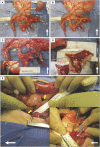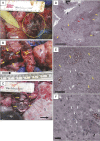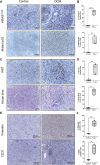Induction of pancreatic neoplasia in the KRAS/TP53 Oncopig
- PMID: 36579622
- PMCID: PMC9884120
- DOI: 10.1242/dmm.049699
Induction of pancreatic neoplasia in the KRAS/TP53 Oncopig
Abstract
The 5-year survival of pancreatic cancer (PC) remains low. Murine models may not adequately mimic human PC and can be too small for medical device development. A large-animal PC model could address these issues. We induced and characterized pancreatic tumors in Oncopigs (transgenic swine containing KRASG12D and TP53R167H). The oncopigs underwent injection of adenovirus expressing Cre recombinase (AdCre) into one of the main pancreatic ducts. Resultant tumors were characterized by histology, cytokine expression, exome sequencing and transcriptome analysis. Ten of 14 Oncopigs (71%) had gross tumor within 3 weeks. At necropsy, all of these subjects had gastric outlet obstruction secondary to pancreatic tumor and phlegmon. Oncopigs with injections without Cre recombinase and wild-type pigs with AdCre injection did not show notable effect. Exome and transcriptome analysis of the porcine pancreatic tumors revealed similarity to the molecular signatures and pathways of human PC. Although further optimization and validation of this porcine PC model would be beneficial, it is anticipated that this model will be useful for focused research and development of diagnostic and therapeutic technologies for PC. This article has an associated First Person interview with the joint first authors of the paper.
Keywords: Oncopig; Pancreas; Pancreatic cancer; Porcine pancreatic cancer.
© 2023. Published by The Company of Biologists Ltd.
Conflict of interest statement
Competing interests The authors declare no competing or financial interests.
Figures





References
-
- Bergeron, S., Lemieux, E., Durand, V., Cagnol, S., Carrier, J. C., Lussier, J. G., Boucher, M.-J. and Rivard, N. (2010). The serine protease inhibitor serpinE2 is a novel target of ERK signaling involved in human colorectal tumorigenesis. Mol. Cancer 9, 271. 10.1186/1476-4598-9-271 - DOI - PMC - PubMed
-
- Boas, F. E., Nurili, F., Bendet, A., Cheleuitte-Nieves, C., Basturk, O., Askan, G., Michel, A. O., Monette, S., Ziv, E., Sofocleous, C. T.et al. (2020). Induction and characterization of pancreatic cancer in a transgenic pig model. PLoS One 15, e0239391. 10.1371/journal.pone.0239391 - DOI - PMC - PubMed
Publication types
MeSH terms
Substances
Grants and funding
LinkOut - more resources
Full Text Sources
Medical
Molecular Biology Databases
Research Materials
Miscellaneous

